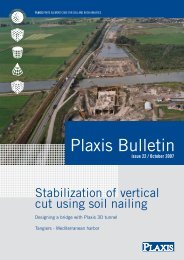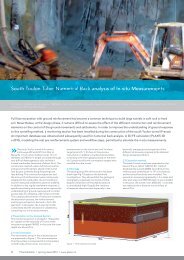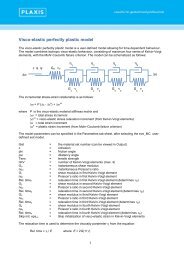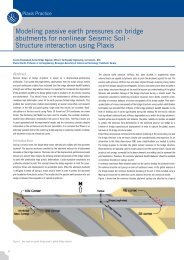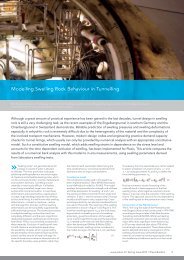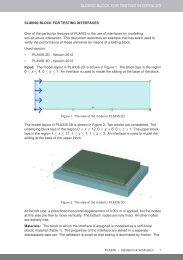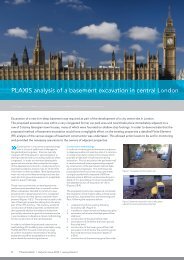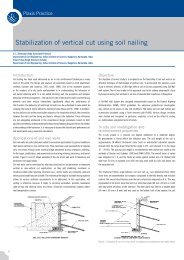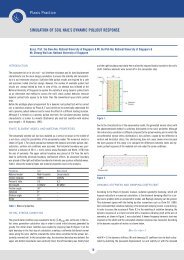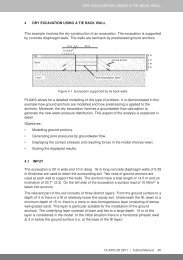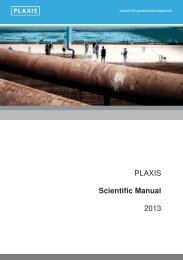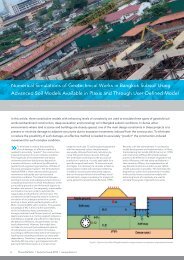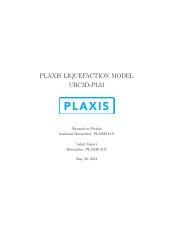Nicoll Highway Collapse: Evaluation of Geotechnical ... - Plaxis
Nicoll Highway Collapse: Evaluation of Geotechnical ... - Plaxis
Nicoll Highway Collapse: Evaluation of Geotechnical ... - Plaxis
Create successful ePaper yourself
Turn your PDF publications into a flip-book with our unique Google optimized e-Paper software.
8mRL and 78 mRL on the excavated side and at RL 68 mRL on the retained side). Removal <strong>of</strong> the 9 th<br />
level strut causes the following events:<br />
1. Both Methods A and B predict formation <strong>of</strong> two plastic hinges (RL 73m and RL 79m) with<br />
large wall toe rotation.<br />
2. Method B predicts failure <strong>of</strong> the 8 th level strut (capacity 3220kN/m) and initiates collapse<br />
within the soil mass. All three <strong>of</strong> the Method B analyses (GIM, GIM* and EBC) show that it<br />
is not possible to re-distribute loads after removal <strong>of</strong> the 9 th levels struts.<br />
3. In contrast, Method A computes loads below the theoretical capacity <strong>of</strong> strut 8 and predicts a<br />
mobilization factor, FS = 1.16 within the soil mass. Therefore, Method A would predict successful<br />
redistribution following failure <strong>of</strong> the 9 th level strut-waler connection.<br />
100<br />
90<br />
Stage<br />
Exc. Level 9 (RL 72.3m)<br />
Removal <strong>of</strong> Strut 9<br />
Method A<br />
Method B<br />
M max<br />
= 2320 kN-m/m<br />
M max<br />
= 2320 kN-m/m<br />
100<br />
90<br />
Elevation, RL (m)<br />
80<br />
Strut Loads<br />
(kN/m)<br />
634<br />
619<br />
677<br />
2157<br />
501<br />
239<br />
3133<br />
804 596<br />
705<br />
704<br />
2097<br />
526<br />
3220<br />
80<br />
70<br />
60<br />
Level<br />
6<br />
7<br />
8<br />
9<br />
Capacity<br />
(kN/m)<br />
1616<br />
2615<br />
3220<br />
2664<br />
Moment<br />
Envelopes<br />
70<br />
60<br />
0.00 0.05 0.10 0.15 0.20 0.25 0.30<br />
Wall Deflection, δ w<br />
(m)<br />
-2000 -1000 0 1000 2000<br />
Bending Moment, M (kN-m/m)<br />
Figure 14. Effect <strong>of</strong> analysis method on load re-distribution following failure <strong>of</strong> the 9 th level strut-waler<br />
connection<br />
4 CONCLUSIONS<br />
The construction <strong>of</strong> the Circle Line Stage 1 in Contract 824 adjacent to the <strong>Nicoll</strong> <strong>Highway</strong> involved<br />
the deepest cut-and-cover excavations in s<strong>of</strong>t marine clay attempted to date in Singapore. In the M3<br />
failure area, the excavation support design included ten levels <strong>of</strong> preloaded cross-lot bracing together<br />
with two rafts <strong>of</strong> jet grouted piles (JGP). The latter constitutes a specialized ground improvement<br />
technology used successfully in prior deep excavation projects in Singapore. Use <strong>of</strong> relatively thin<br />
JGP layers (less than 3m thick) and the specification <strong>of</strong> a sacrificial upper JGP layer were novel aspects<br />
<strong>of</strong> the excavation support system.<br />
The collapse occurred in an area where land was reclaimed in the 1970’s with approximately 5m <strong>of</strong><br />
fill. The site includes deep deposits <strong>of</strong> Marine clays that extend to a depth <strong>of</strong> 40m, infilling a buried<br />
channel in the underlying Old Alluvium which bisects the tunnel alignment in the M3 area. The<br />
undrained shear strength pr<strong>of</strong>ile in the Marine Clay is best interpreted from piezocone records. These<br />
data confirm that the upper units <strong>of</strong> Marine Clay are normally consolidated and can be described by<br />
the design undrained strength ratio, s u /σ’ v = 0.21. The undrained shear strength <strong>of</strong> the Lower Marine<br />
Clay (and lower Estuarine) appear to be lower than this normally consolidated strength line. It is<br />
likely that these units are still underconsolidated due to reclamation. This result is consistent with local<br />
measurements <strong>of</strong> surface settlements prior to construction and implies that the underlying Old Alluvium<br />
is effectively impermeable.<br />
A detailed re-evaluation <strong>of</strong> the local stratigraphy shows that some <strong>of</strong> the diaphragm wall panels installed<br />
the M3 area had toe embedment depths substantially less than the 3m intended in the design.



